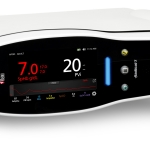Study Investigates Effects of Masimo SpHb®, Noninvasive and Continuous Hemoglobin Monitoring, on Postoperative Anemia and Inappropriate Blood Transfusion in Patients Undergoing Hip and Knee Surgery

ORLANDO, Fla.–(BUSINESS WIRE)–Masimo (NASDAQ: MASI) announced today the findings of an abstract recently presented at the American Society of Anesthesiologists (ASA) 2019 Annual Meeting. In this independent study, researchers at Fukuoka University in Japan evaluated whether using Masimo SpHb® could help avoid postoperative anemia and inappropriate blood transfusion in patients undergoing total hip arthroplasty (THA) and total knee arthroplasty (TKA).1 SpHb, noninvasive, continuous hemoglobin monitoring, provides real-time visibility to changes to hemoglobin between invasive blood samples.
Noting that anemia and blood transfusion are related to morbidity and mortality in surgical patients, Dr. Nakamori and colleagues sought to determine the utility of SpHb monitoring in avoiding postoperative anemia and inappropriate blood transfusion. Patients undergoing THA or TKA were randomly assigned to either an SpHb-guided group (n=73) or routine care (control) group (n=72). In both groups, patients were continuously monitored using SpHb, but in the control group clinicians were blinded to the SpHb data and blood transfusion decisions were made according to traditional clinical signs such as blood loss and hemodynamic parameters. Hemoglobin (Hb) was measured invasively using a laboratory hematology analyzer on the first postoperative day (POD1), with a target Hb value of ≥ 8 g/dL for all patients. The researchers defined two types of blood transfusion as inappropriate: excessive blood transfusion, defined as transfusion of patients with Hb > 12 g/dL, and delayed blood transfusion, defined as transfusion of patients with Hb < 8 g/dL.
The researchers found that Hb on POD1 was not significantly different between the SpHb and control groups, nor was there a significant difference in blood transfusion between both groups. However, in the control group, 7 patients received inappropriate blood transfusion (5 excessive, 2 delayed). No patients received inappropriate blood transfusion in the SpHb group (p = 0.002).
The researchers concluded, “Postoperative monitoring of SpHb cannot reduce blood transfusion nor [have an] effect on Hb at POD1, but it can prevent accidental and transient anemia, and excessive or delayed blood transfusion in patients undergoing THA and TKA.”
SpHb is not intended to replace laboratory blood testing. Clinical decisions regarding red blood cell transfusions should be based on the clinician’s judgment considering among other factors patient condition and laboratory diagnostic tests using blood samples. The transfusion threshold of 8 g/dL was predetermined by the study protocol and may not be appropriate for all patients.
@MasimoInnovates | #Masimo
About Masimo
Masimo (NASDAQ: MASI) is a global medical technology company that develops and produces a wide array of industry-leading monitoring technologies, including innovative measurements, sensors, patient monitors, and automation and connectivity solutions. Our mission is to improve patient outcomes and reduce the cost of care. Masimo SET® Measure-through Motion and Low Perfusion™ pulse oximetry, introduced in 1995, has been shown in over 100 independent and objective studies to outperform other pulse oximetry technologies.2 Masimo SET® has also been shown to help clinicians reduce severe retinopathy of prematurity in neonates,3 improve CCHD screening in newborns,4 and, when used for continuous monitoring with Masimo Patient SafetyNet™ in post-surgical wards, reduce rapid response team activations, ICU transfers, and costs.5-7 Masimo SET® is estimated to be used on more than 100 million patients in leading hospitals and other healthcare settings around the world,8 and is the primary pulse oximetry at 9 of the top 10 hospitals according to the 2019-20 U.S. News and World Report Best Hospitals Honor Roll.9 Masimo continues to refine SET® and in 2018, announced that SpO2 accuracy on RD SET® sensors during conditions of motion has been significantly improved, providing clinicians with even greater confidence that the SpO2 values they rely on accurately reflect a patient’s physiological status. In 2005, Masimo introduced rainbow® Pulse CO-Oximetry technology, allowing noninvasive and continuous monitoring of blood constituents that previously could only be measured invasively, including total hemoglobin (SpHb®), oxygen content (SpOC™), carboxyhemoglobin (SpCO®), methemoglobin (SpMet®), Pleth Variability Index (PVi®), RPVi™ (rainbow® PVi), and Oxygen Reserve Index (ORi™). In 2013, Masimo introduced the Root® Patient Monitoring and Connectivity Platform, built from the ground up to be as flexible and expandable as possible to facilitate the addition of other Masimo and third-party monitoring technologies; key Masimo additions include Next Generation SedLine® Brain Function Monitoring, O3® Regional Oximetry, and ISA™ Capnography with NomoLine® sampling lines. Masimo’s family of continuous and spot-check monitoring Pulse CO-Oximeters® includes devices designed for use in a variety of clinical and non-clinical scenarios, including tetherless, wearable technology, such as Radius-7® and Radius PPG™, portable devices like Rad-67™, fingertip pulse oximeters like MightySat® Rx, and devices available for use both in the hospital and at home, such as Rad-97®. Masimo hospital automation and connectivity solutions are centered around the Iris® platform, and include Iris Gateway®, Patient SafetyNet, Replica™, Halo ION™, UniView™, and Doctella™. Additional information about Masimo and its products may be found at www.masimo.com. Published clinical studies on Masimo products can be found at www.masimo.com/evidence/featured-studies/feature/.
ORi and RPVi have not received FDA 510(k) clearance and are not available for sale in the United States. The use of the trademark Patient SafetyNet is under license from University HealthSystem Consortium.
References
- Nakamori E, Iwashita K, Higashi M, and Yamaura K. Effect of Noninvasive Hemoglobin Monitoring on Postoperative Anemia and Inappropriate Blood Transfusion in Patients Undergoing Total Hip Arthroplasty and Total Knee Arthroplasty: A Randomized Controlled Study. Proceedings from the ASA 2019 Annual Meeting in Orlando, Florida. Abstract #A4197.
- Published clinical studies on pulse oximetry and the benefits of Masimo SET® can be found on our website at http://www.masimo.com. Comparative studies include independent and objective studies which are comprised of abstracts presented at scientific meetings and peer-reviewed journal articles.
- Castillo A et al. Prevention of Retinopathy of Prematurity in Preterm Infants through Changes in Clinical Practice and SpO2 Technology. Acta Paediatr. 2011 Feb;100(2):188-92.
- de-Wahl Granelli A et al. Impact of pulse oximetry screening on the detection of duct dependent congenital heart disease: a Swedish prospective screening study in 39,821 newborns. BMJ. 2009;Jan 8;338.
- Taenzer AH et al. Impact of pulse oximetry surveillance on rescue events and intensive care unit transfers: a before-and-after concurrence study. Anesthesiology. 2010:112(2):282-287.
- Taenzer A et al. Postoperative Monitoring – The Dartmouth Experience. Anesthesia Patient Safety Foundation Newsletter. Spring-Summer 2012.
- McGrath SP et al. Surveillance Monitoring Management for General Care Units: Strategy, Design, and Implementation. The Joint Commission Journal on Quality and Patient Safety. 2016 Jul;42(7):293-302.
- Estimate: Masimo data on file.
- http://health.usnews.com/health-care/best-hospitals/articles/best-hospitals-honor-roll-and-overview.
Forward-Looking Statements
This press release includes forward-looking statements as defined in Section 27A of the Securities Act of 1933 and Section 21E of the Securities Exchange Act of 1934, in connection with the Private Securities Litigation Reform Act of 1995. These forward-looking statements include, among others, statements regarding the potential effectiveness of Masimo SpHb®. These forward-looking statements are based on current expectations about future events affecting us and are subject to risks and uncertainties, all of which are difficult to predict and many of which are beyond our control and could cause our actual results to differ materially and adversely from those expressed in our forward-looking statements as a result of various risk factors, including, but not limited to: risks related to our assumptions regarding the repeatability of clinical results; risks related to our belief that Masimo’s unique noninvasive measurement technologies, including Masimo SpHb, contribute to positive clinical outcomes and patient safety; risks related to our belief that Masimo noninvasive medical breakthroughs provide cost-effective solutions and unique advantages; as well as other factors discussed in the “Risk Factors” section of our most recent reports filed with the Securities and Exchange Commission (“SEC”), which may be obtained for free at the SEC’s website at www.sec.gov. Although we believe that the expectations reflected in our forward-looking statements are reasonable, we do not know whether our expectations will prove correct. All forward-looking statements included in this press release are expressly qualified in their entirety by the foregoing cautionary statements. You are cautioned not to place undue reliance on these forward-looking statements, which speak only as of today’s date. We do not undertake any obligation to update, amend or clarify these statements or the “Risk Factors” contained in our most recent reports filed with the SEC, whether as a result of new information, future events or otherwise, except as may be required under the applicable securities laws.
Contacts
Masimo
Evan Lamb
949-396-3376
elamb@masimo.com

